FRIDAY
MAY 31 - 2013
SOUTH
MOOR
No
orchids!
It was a fine warm
morning, just right, I thought, to enjoy the
experience of lots of lovely Southern Marsh Orchids on
the South Moor. I had a good walk around the main
orchid field for about 45 mins, but failed to see a
single orchid, apart from the dead spikes from last
year which are still standing.
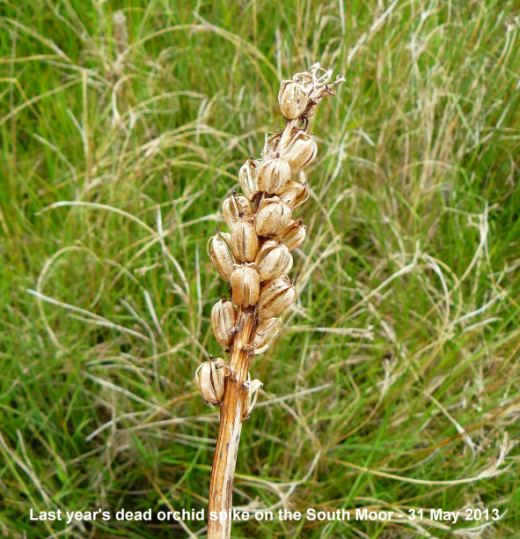
My reaction was much
the same as failing to find Wild Clary on the
Christopher Way wayside yesterday. What the heck has
happened to them? I certainly recall seeing thousands
of Southern Marsh Orchids in flower on the moor in
late May in the last few years. In fact, there have
been bumper counts of over 9,000 in the last three
years. Maybe, hopefully, it is just the very very late
spring?
Other
flowers
The late spring also
probably accounts for the paucity of Ragged
Robin on the South Moor; with only about 40 plants
in flower. Cuckooflowers were dotted around the
field, though these are on the wane, as they are on
the Bridge Road Wayside. But, Yellow Flag was
fully out and looking splendid.
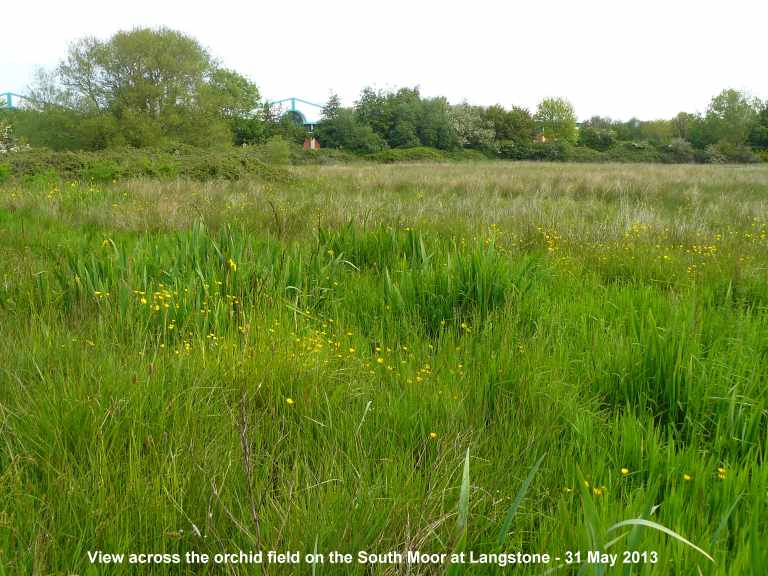
Sedges
These were plentiful
as usual on the moor, particularly Divided Sedge and
False Fox Sedge which we also have on Brook Meadow.
Surprisingly, I did not see any Distant Sedge which is
common on Brook Meadow. I also found some Hairy
Sedge which I have not yet seen on Brook Meadow
this year, though I did find one tuft on the Railway
Wayside.
Common
Spike-rush grows in dense green patches on the
South Moor, which stand out clearly from the
surrounding vegetation. Based on memory, they seem to
be more common than in previous years; the largest
area is almost beneath the two tall electricity poles.
The characteristic
sedge of the South Moor, which I have never seen on
Brook Meadow, is Black Sedge. This is
distinguished by its very long leaf-like bracts, the
lowest about as long, or longer than the
inflorescence, and its dark (black) spikelets.
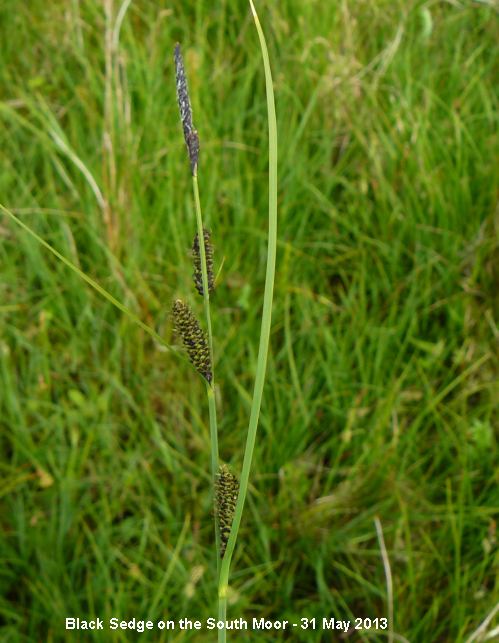
Insects
There were several
whites feeding mostly on the Cuckooflowers. I did not
examine them all, but those which I did turned out to
be Green-veined White.
BROOK
MEADOW
Sedges
I went over to the
meadow to check on the sedges in the Lumley area to
see how they compared with those on the South Moor.
Divided Sedge and False Fox Sedge were both present in
good numbers, but also Distant Sedge which I did not
find on the South Moor. There was nothing that looked
remotely like Black Sedge.
Slender
Spike-rush
However, I did make an
exciting find of what I am fairly sure is the Slender
Spike-rush (Eleocharis uniglumis) that John
Norton discovered on the Lumley area on June 6 last
year. Slender Spike-rush differs from Common
Spike-rush in having slenderer stems as shown in the
following photo of the two forms.
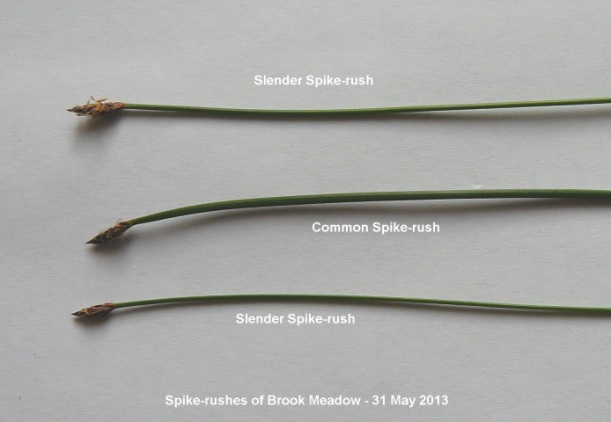
Slender Spike-rush
also only has the lowest glume of the spikelet without
a floret; in Common Spike-rush both the two lowest
glumes are empty. I checked this in the microscope and
only the slender type had the spikelet. This discovery
made me wonder if the Spike-rush on the South Moor
could have been Slender Spike-rush. I shall need to
check sometime.
Other
observations
The single Southern
Marsh Orchid is developing well on the orchid
area, but I still cannot find a trace of any others.
Yellow Rattle is flowering for the first time
with lots to come. There is still no sign of any
Ragged Robin on the Lumley area.
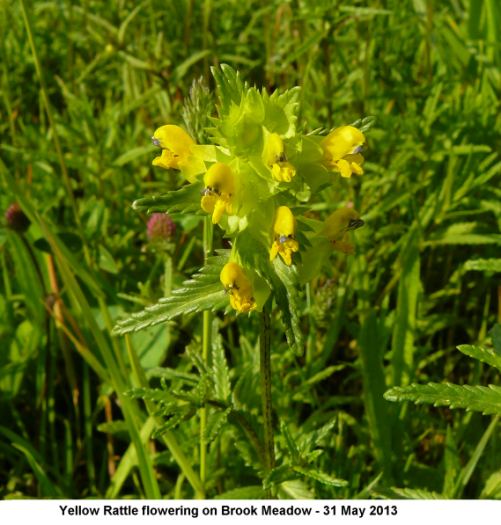
THURSDAY
MAY 30 - 2013
WAYSIDES
NEWS
Hairy
Buttercup
I confirmed the
identification of the Hairy Buttercup that Jane and I
noticed on the Emsworth Railway Wayside yesterday. I
managed to lift the plant to establish that it had
roots and not bulbs. I replaced the plant back in the
same spot with no apparent damage done. There are
several other similar buttercup plants on the site
which are also probably Hairy Buttercups.
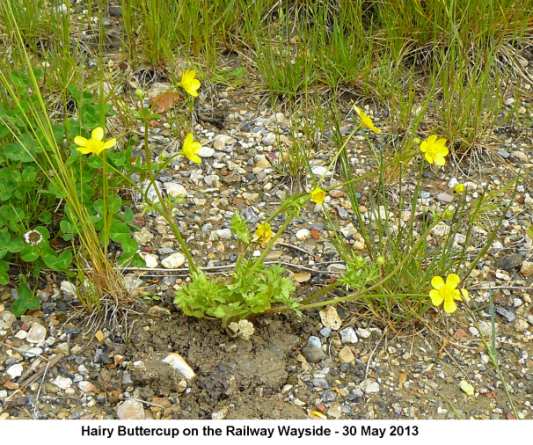
Ladybird
larva
While I was on the
Railway Wayside I came across a 7-spot Ladybird larva
with the four pairs of coloured marking on its
abdomen.
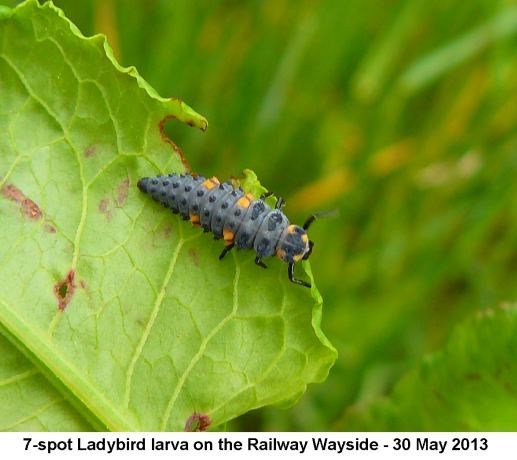
For
more waysides news go to . . . http://www.emsworthwaysides.hampshire.org.uk/few-NEWS-current.htm
MILLPOND
NEWS
Great
Black-backed Gull chicks
The three Great
Black-backed Gull chicks were clearly visible on the
centre raft this morning from Slipper Road. One of the
chicks looks less active and well developed than the
other two and tended to remain hidden in the
vegetation. This is the one on the left in the photo.
Last year the gulls lost one of their three chicks, so
this scenario could happen again.
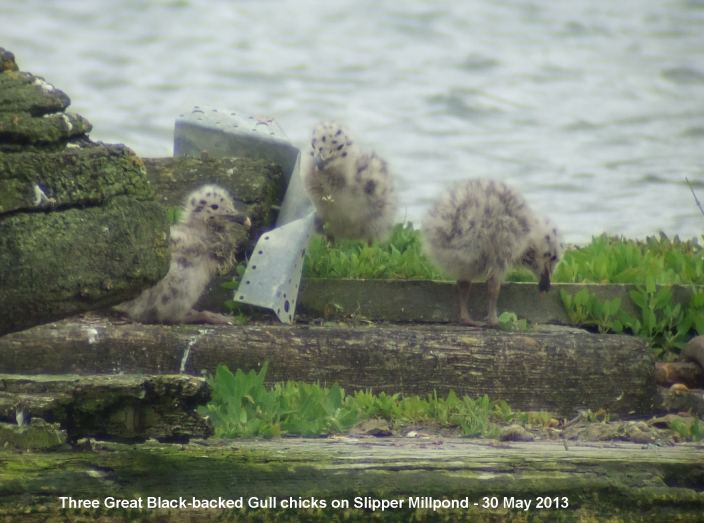
While I was taking
photos from Slipper Road, one of the adult gulls
repeatedly 'buzzed' me, by flying over my head with
aggressive calling, 'ga, ga, ga, ga' . I recall, this
also happened last year. It was interesting that a
pair of Mallards that were on the raft throughout my
visit were tolerated by the adult gull.
BROOK
MEADOW
Common
Comfrey
There is a very
attractive Common Comfrey plant in full flower on the
Lumley area of Brook Meadow. The flowers of Common
Comfrey are in what Rose describes as 'forked, coiled,
cymes' with long calyx teeth. A cyme is an
inflorescence in which the terminal flower opens first
followed in succession by the lateral flowers. The
colour of the flowers in Common Comfrey varies, but in
this one the petals are cream and the sepals purple.
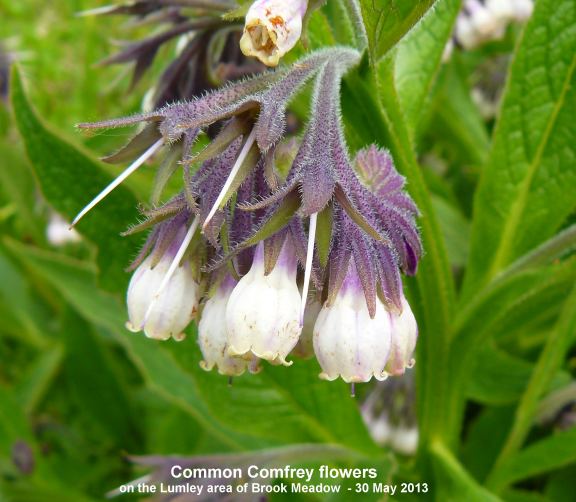
The New Atlas: "This
tall perennial herb occurs on the banks of streams and
rivers, in ditches, fens and marshes, and on damp road
verges. Generally lowland, reaching 320 m near Buxton
(Derbys.). Native (change +0.34). S. officinale was
over-recorded for S. x uplandicum (Russian Comfrey) in
the 1962 Atlas and this confusion still obscures its
true distribution. European Temperate element; also in
C. Asia and widely naturalised outside its native
range."
GARDEN
NEWS
This afternoon I
noticed two Stock Doves feeding on the
scattered seeds on the back garden grass. This is my
second sighting of these rare garden birds this year -
the other sighting was on April 30. The photo shows a
Woodpigeon for a useful comparison.
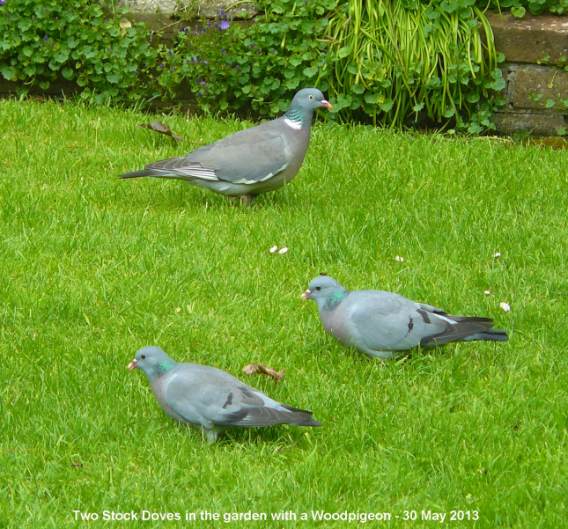
INSECT
COURSES
Bryan Pinchen has a
couple more insect courses coming up at Chilcomb
(Ladybirds, Grasshoppers and crickets et al). They are
booking up already so anyone interested may need to
book soon.
http://www3.hants.gov.uk/chilcomb-eventsdetail?id=187200
http://www3.hants.gov.uk/chilcomb-eventsdetail?id=187201
WEDNESDAY
MAY 29 - 2013
MILLPOND
NEWS
Swan
'litter nest'
Juliet Walker reports
that the swan's 'litter nest' on the town millpond has
now become an island! She says, "At least this gives
the female the chance to take drinks of water without
leaving her post on the eggs. Various bits and pieces
are still being added to the structure. Let's hope
everything continues to go well. The pair seem to be
very good parents." My estimate of the hatching date
is June 7.
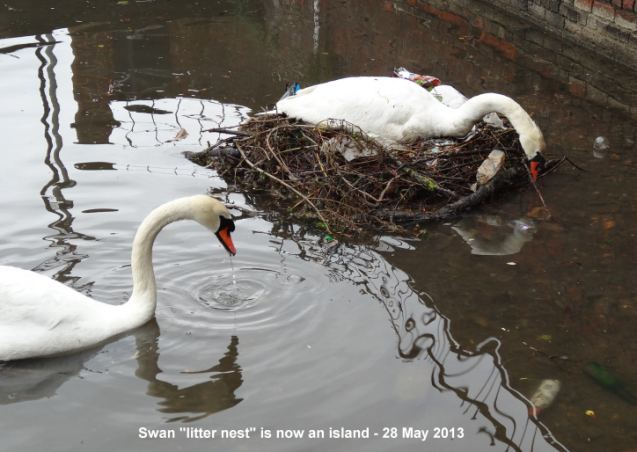
Coot
'litter nest'
Juliet was also
interested to watch the antics of the Coots building
their 'litter nest' on the town millpond. What she
assumes is the male swims around in a very purposeful
way collecting all sorts of bits and pieces and
sometimes returns to the nest with pieces of wood far
larger than he is! The attached pictured shows him
having deposited a large sodden heap of what looks
like plastic on the nest.
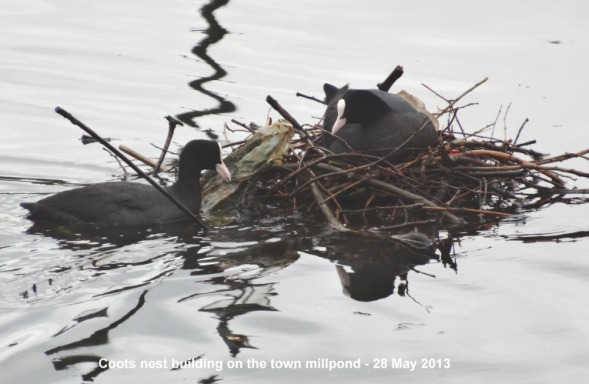
Peter
Pond nest
Maurice Lillie was
lucky enough to see a great sight this morning. He
says, "I knew the swans had four eggs but as I walked
by, she straightened herself, got to her feet, looked
down, decided to do her usual check up, 1, 2, 3, 4, 5
er excuse me, 6, 7 and, good lord, 8. She then
proceeded to roll them around the nest with beak and,
surprisingly, her foot, then re-seated herself. My
estimate of the hatching date is June 3 - next
Monday.
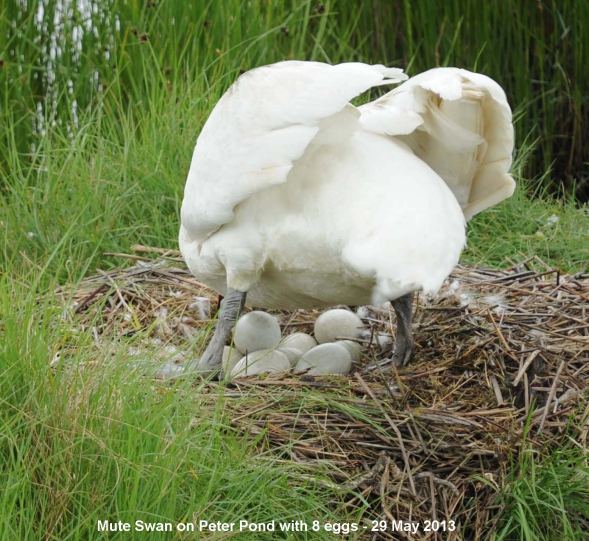
HAYLING
OYSTERBEDS
Chris Cockburn
provides a new update on breeding activity at the
oysterbeds.
"The gull hatch is now
in full swing - loads of chicks on both islands.
Tuesday's prolonged rainfall seems to have taken only
a light toll of small chicks - a few bloated corpses
were blown ashore this afternoon when the northerly
wind picked up - food for the crows! Big tides on
Monday & Tuesday (c5 metres ACD) night probably
flooded out gull nests on the saltmarsh of South
Binness Island and any little terns nesting on the
shingle mounds on Baker's Island must have been
flooded out. Noisy pairs of Mediterranean gulls were
noticeable today, which is typical behaviour after
failing as is their not-so-innocent forays over the
colonies at the Oysterbeds. Apart from hungry Meds,
which get away with murder, the black-headed gulls had
to beat off a foraging non-adult great black-backed
gull and, for the first time at the site, a buzzard
was successfully chased off (possibly one of the local
buzzards). The number of apparently nesting common
terns will probably be similar to the 17 pairs in
2012. Little terns were again in much evidence on the
shingle recharge (mating etc) and a ringed plover was
acting suspiciously!
OTHER
NEWS
Tony Wootton saw 4
Swifts screaming over his house in Highland Road
today. I did not see any over ours today, though I was
out most of the morning.
MONDAY
MAY 27 - 2013
BROOK
MEADOW
Azure
Damselfly
While walking down the
Bramble path on Brook Meadow this morning, I spotted a
pale damselfly which settled on a nettle leaf for a
photo. From the black stripes on its thorax and its
general greenish colouring my guess is that it is a
female Azure Damselfly. The male is far easier to
identify with its all blue colouring.

First
Southern Marsh Orchid
I have been looking
for any signs of orchids on the 'orchid area' of Brook
Meadow for a couple of weeks without seeing anything.
However, today I found the first Southern Marsh Orchid
flower spike just starting to open in the usual spot
on the east of the area. My granddaughter, Nell, asked
to see the rarest flower on Brook Meadow, so I took
her to see the orchid which she marked with a twig.
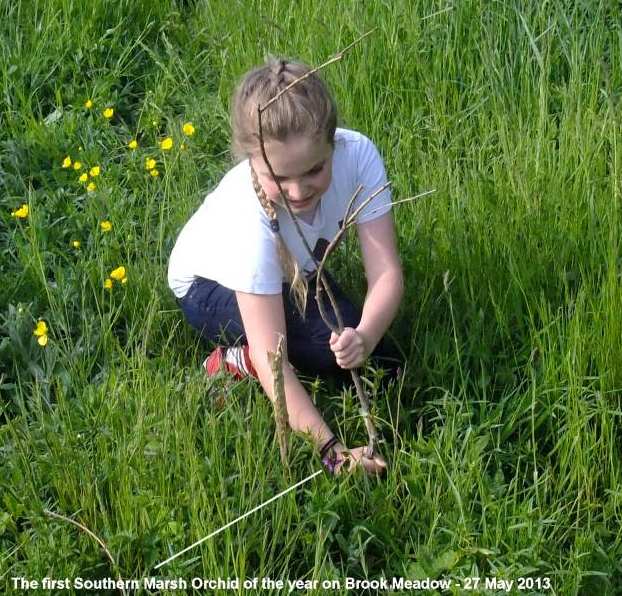
Two Southern Marsh
Orchids were planted here by Nigel Johnson in June
2007 and they have gradually increased over the years;
7 were present in 2011 and 10 in 2012. Hopefully, at
this rate we should have a reasonable showing this
year, but I am not holding my breath with such a
rotten spring.
Small
Yellow Underwing - Panemeria
tenebrata
I am again grateful to
Tony Davis for the correct identification of the small
brown moth with yellow spots on its wings that I came
across on Brook Meadow this morning. I thought it was
Pyrausta aurata but Tony put me on the right track
with Small Yellow Underwing. According to UK Moths it
is a day-flying species which prefers sunny weather.
This diminutive species frequents meadows, grassy
downland and other open areas and is widely
distributed, though local, over much of mainland
Britain as far as southern Scotland. On the wing in
May and June, it visits various flowers in grassy
meadows. The larvae feed on the flowers and seeds of
mouse-ear, especially common mouse-ear. See . . .
http://ukmoths.org.uk/show.php?bf=2397
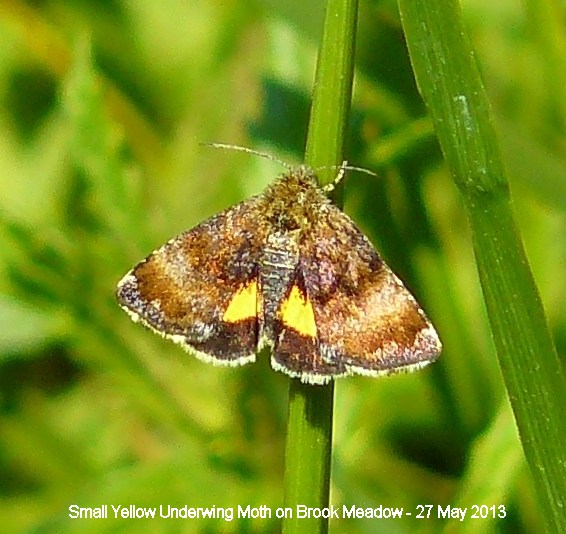
PETER
POND
First
Reed Warbler
I was pleased to hear
a Reed Warbler singing from the reedbeds in the south
west corner of Peter Pond. This was the first I have
heard from Peter Pond this year, much later than
usual. Characteristically, it remained hidden for most
of the time I was there, but I managed to catch a
brief glimpse of it in this photo. There is nothing in
the northern reedbeds where they usually are.

OTHER
NEWS
Horse
Chestnut colours
Today, I was asked a
very simple question which I did not know the answer
to. Why do some Horse Chestnut trees have white
flowers and others have red flowers? All I knew is
they just do! So I looked it up on the internet.
The Forestry
Commission web site provided the answer - the red is a
hybrid The normal white-flowering horse-chestnut is
Aesculus hippocastanum. But, a number of
hybrids between different Aesculus species are also
grown in parks and gardens. The most common of these
is the red-flowering Horse Chestnut called
Aesculus x carnea, which is a cross
between A. hippocastanum and A. pavia. See . . .
http://www.forestry.gov.uk/fr/INFD-6Q3AS5
SUNDAY
MAY 26 - 2013
Swifts
return
Three Swifts were
flying low over my garden in Bridge Road, Emsworth,
this morning, probably the same three birds that we
have seen several times in the past two weeks. They
disappear for days on end and then suddenly appear
again. Could they be nesting locally?
Young
Starlings
Starlings were the
other main bird seen over the garden, constantly
flying around in small groups, whistling and
screeching. They are almost certainly youngsters from
a local brood, but we have not seen any come down onto
the garden, even when we were not sitting there.
Tree
blossom
The Rowan
plantation on the east side of Brook Meadow
(planted in memory of Gwynne Johnson in May 2005) is
now in full blossom, better than I have seen it for
many years. Is it just me, or is the blossom on trees
this spring better than usual?
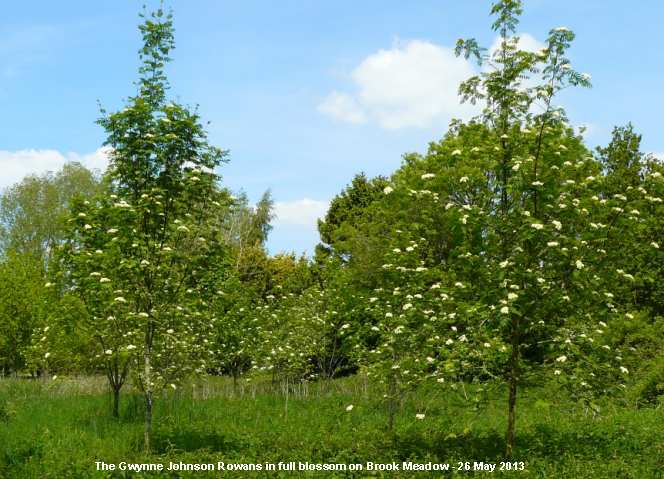
Another example of
good tree blossom is the Holly bush on the east
side of Slipper Millpond which is covered in white
flowers.
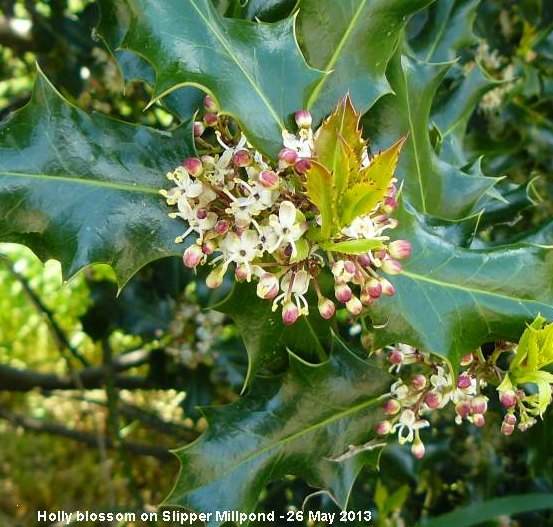
Cuckoo
calling
I met Pam Phillips on
Brook Meadow this morning and she told me the Cuckoo
that has been calling in the early morning in the
Lumley Road area was calling loudly from the garden of
Gooseberry Cottage at about 7am this morning, a bit
later than usual.
Wood
Mouse
Patrick Murphy had an
interesting visitor to his garden this lunch time,
namely a Wood Mouse unmistakable with its very large
ears and eyes. Patrick says, the mouse kept coming out
from some plants around base of apple tree and to feed
on some crumbs we had put out for the birds and then
darted back into the foliage before repeating the
exercise. Patrick wonders if it was feeding young,
which seems highly likely.
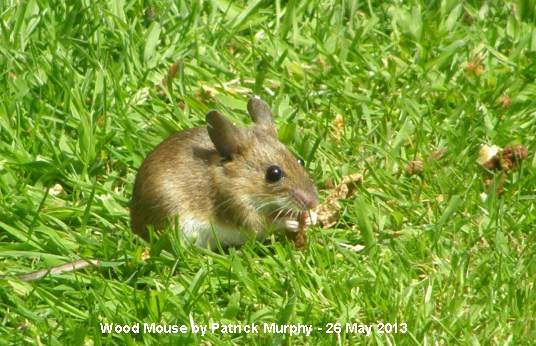
Wood Mouse often comes
into gardens to take food put out for birds. I used to
have one that climbed onto the bird feeders. My book
says it is proably the most widespread and abundant
British mammal.
An
obliging Kestrel
Francis Kinsella came
across a very obliging male Kestrel as he was walking
from Westbourne to Emsworth this afternoon. These
stunning photos were taken near the electricity
substation at the start of the footpath through the
fields behind Westbourne Avenue. Francis says he was
able to walk right past the bird, passing within 3 or
4 feet on his way down to Brook Meadow.
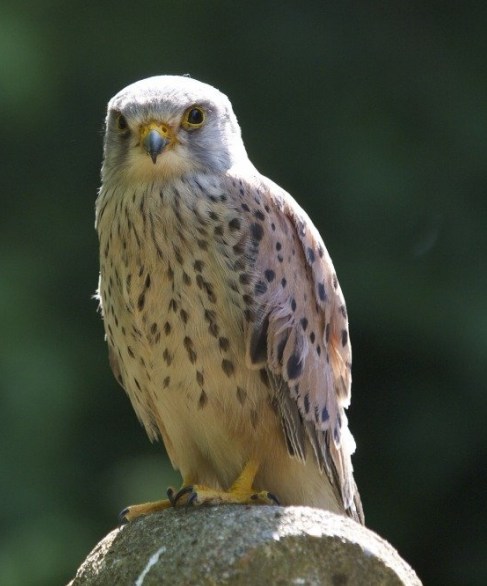
'I've
got my eye on you', he seems to be saying
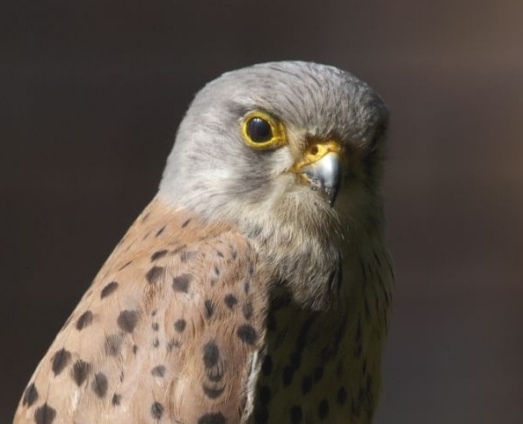
SATURDAY
MAY 25 - 2013
Great
Black-backed Gull chicks
I went down to Slipper
Millpond with the scope at about 9am this morning.
From the western path I could clearly see three Great
Black-backed Gull chicks in the nest on the centre
raft. The photo clearly shows two of the chicks
beneath the gull on the left which I think is the male
from the relative size of its bill. The third chick is
tucked away deeper in the nest and is not visible. I
went down to have another look this afternoon at about
4pm and again clearly saw the three chicks. They also
had three chicks last year, but they lost one.
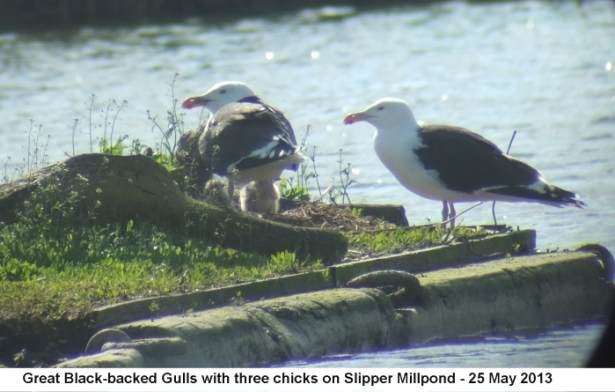
Young
Starlings
Leslie Winter has a
nesting box of baby Blue Tits being fed and this
afternoon the Starlings came down with their
youngsters to feed. What good news that is. I
regularly used to have crowds of young Starlings in my
garden, but not any more.

Hollybank
Woods
Ros Norton reported on
this morning's walk by the Havant Wildlife Group.
The report is on the
Havant Wildlife Group web page at . . .
http://familyfellows.com/hwg-walk-reports-2013.htm
FRIDAY
MAY 24 - 2013
EMSWORTH
Great
Black-backed Gull chicks
Sharon, whose house in
Slipper Road overlooks Slipper Millpond, phoned to say
that two Great Black-backed Gull chicks were on the
raft, hatching one day earlier than I predicted. I
popped down in the car with the scope, but could only
find one; the other must have been snuggled under its
parent's body; not surprising since the weather was
foul, cold wet and windy. But despite the conditions I
managed to get a digiscoped pic.

Longhorn
Moths
I am very grateful to
Tony Davis for correctly identifying the insects that
I labelled as 'caddis flies' on yesterday's blog as
the longhorn moth Adela reaumurella.
Tony added, "If we ever get any nice weather you may
see the males doing their 'dancing' flight during the
day. Only the males have the long antennae as per your
photograph."
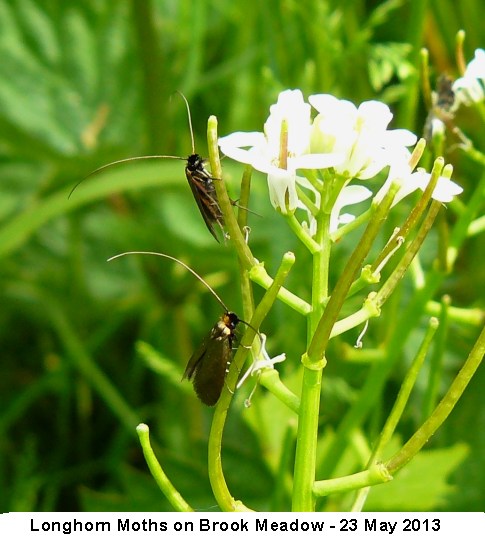
Tony's note reminded
me of the report I had from Tony Poulett on 25 April
2011 of a swarm of these moths in his garden in North
Emsworth in April 2011. From a distance Tony said they
looked like a mist cloud. I also recall seeing a swarm
of them around the shrubs near the cliff edge at
Bouldner on the Isle of Wight in 2011.
House
Martins
I have often commented
that, as far as I am aware, House Martins have not
nested in Emsworth for the past 25 years at least.
However, I read on Hoslist today a message from
Richard Creer who has had half a dozen House Martins
flying around his Emsworth house just over the border
in West Sussex since the May 8th. He says, in past
years they have just passed through in the Spring, but
this year they seem to be sticking around at least for
the moment. I wonder if they will nest?
Swifts
I have not seen any
more Swifts in Emsworth after the three seen over
Bridge Road on May 18. The general opinion is that
with the continuing cold weather, and lack of flying
insects, birds will be searching far and wide for food
and far more interested in surviving than breeding!
This probably applies to most birds this spring.
OTHER
NEWS
Southern
Hawker ?
Tony Wootton got a
rather nice image of a male Southern Hawker while he
was on holiday in Somerset last week and thinks it is
pretty early. Well, I certainly have not seen one or
heard of anyone locally seeing one. I usually see my
first in July. Actually, in my book Tony's image looks
more like an immature male with the pale abdomen
colours.
. .
. is Hairy Dragonfly
John Bogle corrects -
The dragonfly in question is in fact a male Hairy
Dragonfly. When I was in Kent there were everywhere in
my 'local patch' in early spring - our earliest
emerging dragonfly I think. I've yet to see one in
Hampshire but I'm sure they are around here
somewhere!
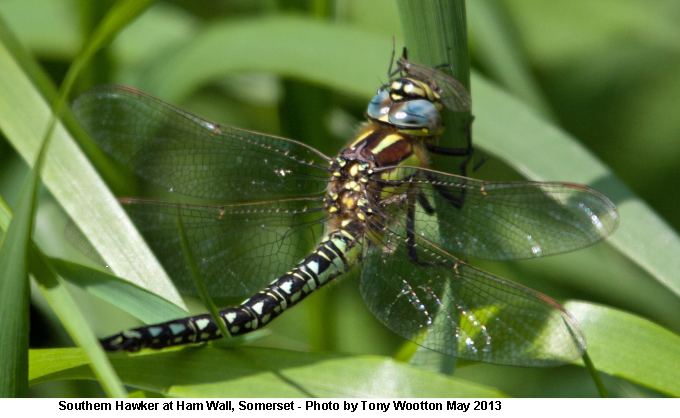
Colin's
bugs
Colin Vanner sent me a
few of his recent bug pics. Here are two I found
particularly interesting.
The Bee-fly showing
well its furry body from which it gets its name and
its long proboscis.

And the Scorpion
Fly showing well the male abdomen turned up giving
the insect its common name.
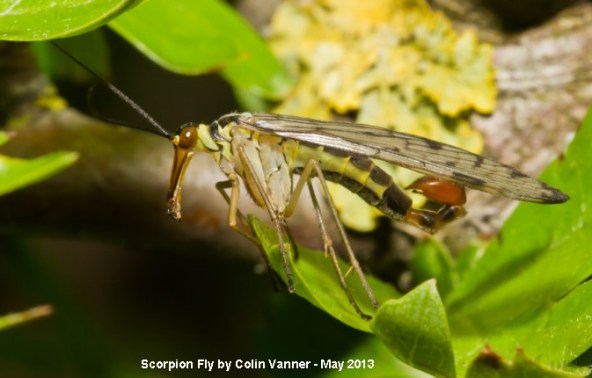
THURSDAY
MAY 23 - 2013
BROOK
MEADOW
Scorpion
Fly
I found yet another
Scorpion Fly on the Seagull Lane patch this morning,
the third we have had on Brook Meadow in the past week
or so. They must be particularly common at present -
or possibly just eye-catching!

David Search also got
one during his insect survey yesterday. He says it was
a male Panorpa germanica which is very common although
Bryan Pinchen did not record it during his survey 3
years ago.
Caddis
flies - CORRECTION
I am very grateful to
Tony Davis for correctly identifying the insects that
I originally labelled as 'caddis flies' as the
longhorn moth Adela reaumurella. Tony
added, "If we ever get any nice weather you may see
the males doing their 'dancing' flight during the day.
Only the males have the long antennae as per your
photograph."

Whitethroat
I got a nice photo of
the north meadow Whitethroat singing well and
prominently on the willow saplings just below the
north path. I heard another singing below the
causeway. I think a third is on the east side of the
north meadow.

Sedges
I found the first
tufts of Spiked Sedge on the centre meadow. Divided
Sedge and Distant Sedge are now fairly abundant on the
east side of the Lumley area along with some False Fox
Sedge, though I have yet to see any Hairy Sedge or
Common Spike-rush which also grow in this area. Grey
Sedge lines the edge of Lumley Road, but the spot
where Remote Sedge usually grows on the edge of the
Lumley Stream is now overgrown with other plants.
Greater
Celandine
Three plants of
Greater Celandine are now in flower at the end of the
path leading from Seagull Lane to Lumley Mill, though
most of the delicate yellow petals have been blown off
by the wind. Note: these plants are not on the Brook
Meadow site.
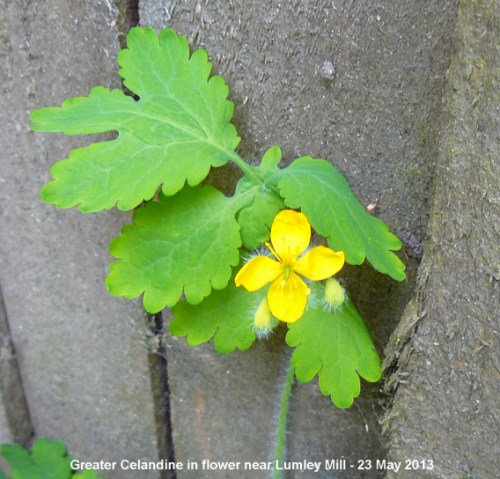
SLIPPER
MILLPOND
The Great Black-backed
Gull was sitting snugly on her nest on the centre raft
when I passed this morning in company with a Mallard.
There is not long to go before hatching which I have
estimated at May 26.
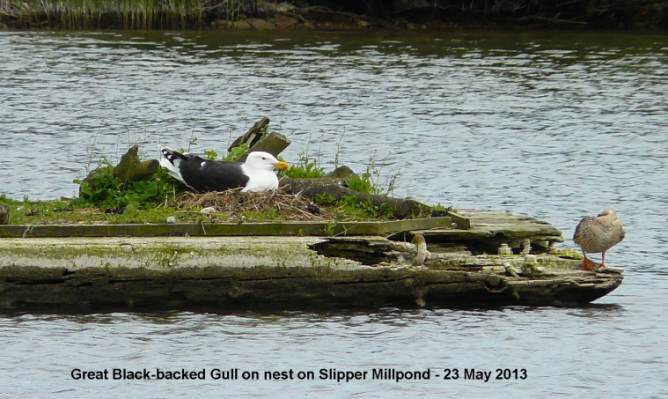
There is a dead
Black-headed Gull on the south raft; this could be the
work of the Great Black-backed Gulls, though I have
occasionally seen dead gulls on the rafts in previous
years. The Coot pair from the north raft still has
their one remaining chick. The adult is back in the
nest box for a second try. Sea Club-rush is just
starting to show its spikelets on the west side of the
pond. Tree Mallow is also now in flower on the
side of the pond as is Silverweed.
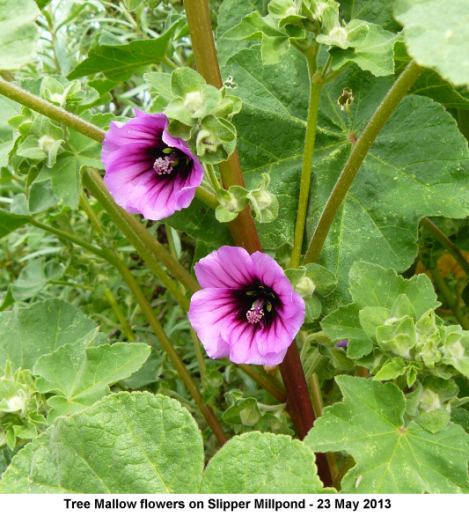
OTHER
NEWS
Common
Tern with crab
Mike Wells was at
Hayling Oysterbeds yesterday afternoon (Wed) watching
a Common Tern 'fishing'. Mike was very interested to
ascertain that one of its catches was a crab, which it
grabbed in about 12 inches of water. He thinks it
certainly looked like a 'soft-back', which is a state
the crab has after a complete shedding of its outgrown
shell, legs, pincers etc.. This condition of crab is
very desirable both to birds and predatory fish, so,
would be easily eaten by a tern.
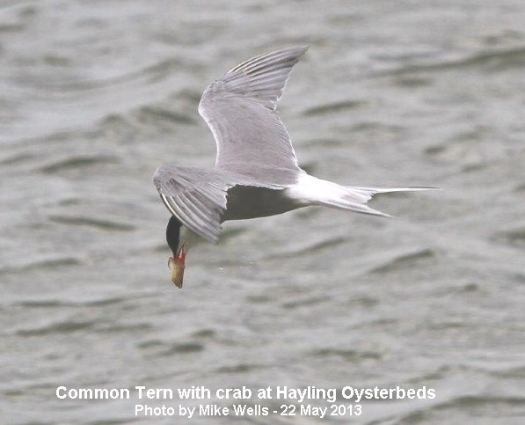
Fox
cubs in garden
Susan Kelly has a
litter of five fox cubs in her South Emsworth garden,
still at the fat and fluffy and curious stage. "Last
week, very early one morning, two of them burst out of
the bushes in pursuit of a bumblebee and ran straight
past my feet"!
She was out watching
them in the gloaming at 9.30 yesterday evening, from
only a few feet away. "They were playing boisterously
in a corner of the garden near the main earth, hiding
behind the apple trees and jumping out. Magic, but
very noisy." What a great experience.
WEDNESDAY
MAY 22 - 2013
HOLLYBANK
WOODS
I had a very good walk
through Hollybank Woods this morning in fine but
cloudy weather. The conservation group have their
regular workday on Wednesday mornings and volunteers
were hard at work clearing trees and making fences.
Andy told me that the deer were not grazing off the
new regeneration of tree growth this year like they
usually did. He thought there must be plenty of food
elsewhere in the woodland.
Birds
I heard several
Blackcaps and Chiffchaffs singing, along with Song
Thrush and Blackbird and other common woodland birds,
but no sound of Willow Warbler this year.
Flowers
The most abundant wild
flower in the woods was Wood Speedwell with its
bright blue flowers with hairs all round the stems,
not just in two lines like Germander Speedwell.

Andy told me the
Early Purple Orchids were in flower on
Longcopse Hill, but not in any great numbers. I did
not have time to check them today. The small patch of
Ransoms (Wild Garlic) is flowering on the side
of the north-south main track. I believe this was
planted several years ago Jill von Westarp.
Crosswort was flowering well in the Holly Lodge
clearing along with very good crops of Sweet Vernal
Grass and Field Wood-rush in the south of the
area.
The Julilee open
area to the north of the old Holly Lodge clearing
was looking very fine with a variety of flowers,
grasses and mosses creating a beautiful kaleidoscope
of colours. The conservation group has constructed a
dead wood fence behind the Jubilee hedgerow to provide
cover and extra warmth.
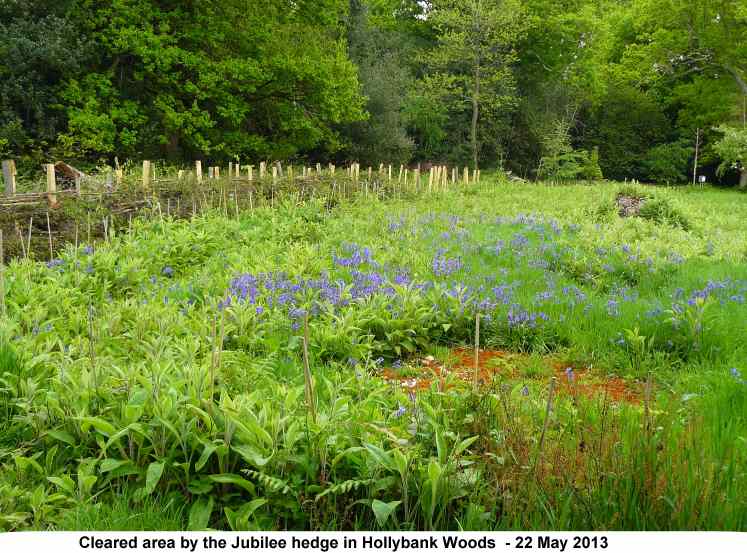
Sheep's Sorrel
was one new plant in this area, which can be
identified from its leaves which have basal lobes
pointing sideways or forwards.
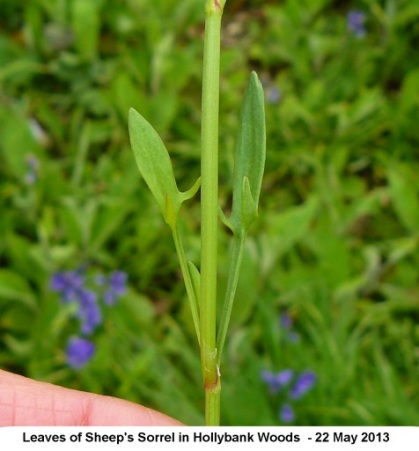
One target was to
check on the native wild version of Lily of the
Valley which I was delighted to find with 12
flower spikes. Excellent work by the conservation
group to discover and protect it.

Bluebells are
now looking especially good along the north eastern
path near the Emsworth Common Road. However, those on
the south eastern path, which are usually better are
having to compete with burgeoning Bracken.
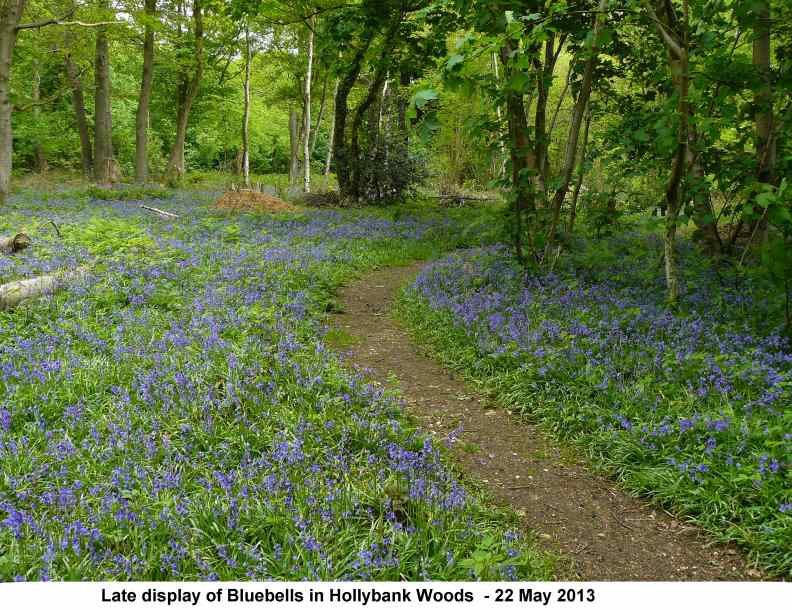
Grasses
etc
I have never seen so
much Wood Millet in the woods. This charming
grass with delicate panicles has been very scarce in
previous years, but this year it is growing well in
several areas, particularly the new open Jubilee area
and the south eastern Bluebell area. My camera does
not do it justice. you need to see it for real. Super.
I also found Wood Melick - though far less in
quantity.
Best find of all was a
good tuft of the scarce Dense-headed Heath
Wood-rush (Luzula multiflora ssp congesta) (only
one that I could see) in the usual spot at the
junction of several paths just east of the south
eastern Bluebell area. This plant was originally
discovered in Hollybank Woods on May 11, 2002 by my
friend Gwynne Johnson, now sadly deceased, but her
memory lives on in these plants which come up every
year.
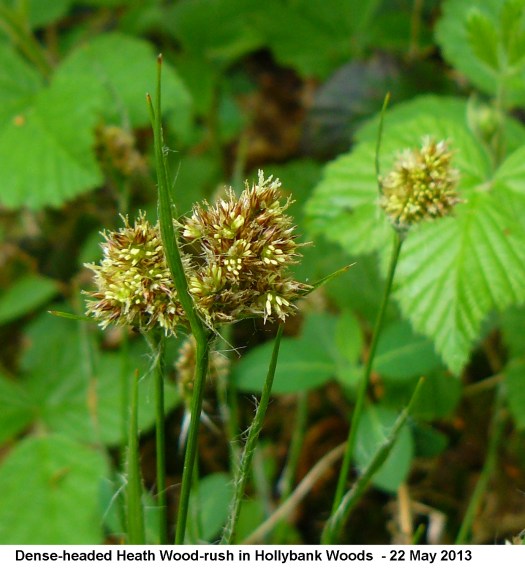
Insects
I saw several ginger
Bumblebees which I assume were Bombus pascuorum. The
only butterfly of the morning was yet another
Green-veined White.

OTHER
NEWS
Turtle
Dove in Havant
Martin Hampton was
pleased to read in yesterday's blog about the Turtle
Dove sighting in 'his' bit of Havant. Martin has been
working on his community 'meadow' two evenings and has
heard the bird purring both days and had started to
doubt his own ears until he read that others too had
heard and seen the bird. Martin also mentions that he
had a male Bullfinch feeding on a sunflower seed
feeder in his front garden in Lower Grove Road for the
first time ever.
I went over to Lower
Grove Road this afternoon and also heard the Turtle
Dove purring from trees behind Martin's community
'meadow'. So, it looks as if it may be staying for a
while? The Turtle Dove we had on Brook Meadow in
Jun-Jul 2008 stayed with us for 6 weeks.
Reed
Warbler on Baffins Pond
Eric Eddles was very
excited to tell me the brilliant news that they have a
Reed Warbler in the North East reed bed, which is
certainly a first for Baffins Pond. Here is Eric's
photo of the bird. Eric also says there are two
families of Canada Geese on the pond, one pair with
five goslings and the other with six and all growing
up fast.

Hayling
Oysterbeds
Peter Milinets-Raby
took his son in his pram to Hayling Oysterbeds at high
tide this morning. The wader roost consisted of 62
Oystercatcher, 2 Whimbrel, Bar-tailed Godwit, Ringed
Plover, 6 Dunlin, 2 Sandwich Tern, Great Crested Grebe
off shore. Here is Peter's photo of the great gull
show on the 'tern islands' in the lagoon. Cover up
your ears as it is noisy! Peter says, some Med Gulls
were nesting and 4 Little Terns looking very
interested in the new shingle bit! Spot them if you
can!
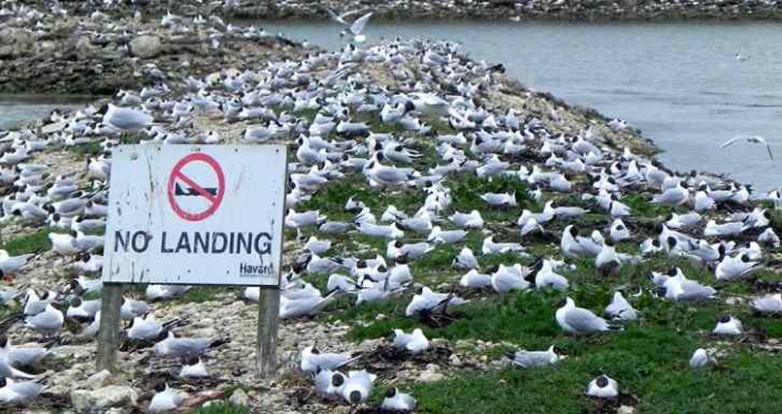
TUESDAY
MAY 21 - 2013
BROOK
MEADOW
Seagull
Lane patch
The Seagull Lane patch
which the conservation group cleared of brambles last
year is now looking green and luxurious with a massive
growth fresh grasses, mainly Rough Meadow-grass,
Cocksfoot and Barren Brome, peppered with the umbels
of Cow Parsley. The three planted sapling Oaks and the
Red Oak are sprouting fresh leaves and all look very
healthy. The leaves of the Red Oak are much sharper
than the native ones.
A
view of the Seagull Lane patch looking north towards
the railway line
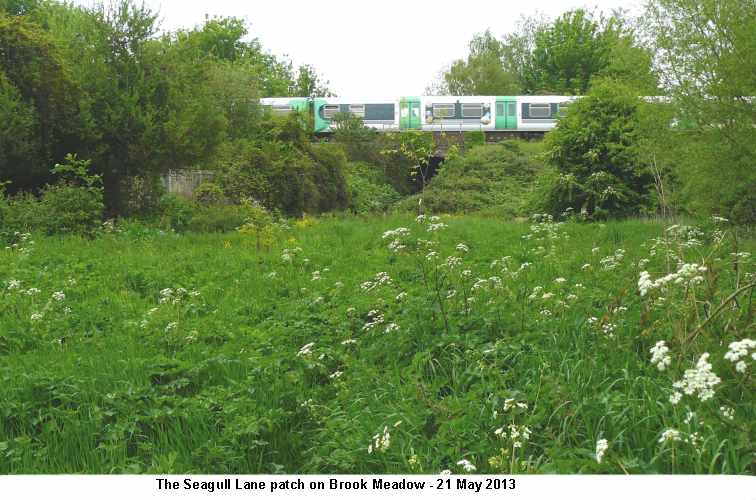
Green-veined
White
I found a Green-veined
White on the Seagull Lane patch with almost pure white
upper wings with just a hint of the green veins
showing through. This feature is characteristic of the
first brood males. I am surprised by the number of
Green-veined White butterflies I have seen this
spring, far more than the other two common whites.

Scorpion
Fly
Ralph Hollins provided
the answer to the mystery fly photographed by Brian
Lawrence on Brook Meadow yesterday. It was a Scorpion
Fly, probably Panorpa communis. Here is Brian's photo
again.
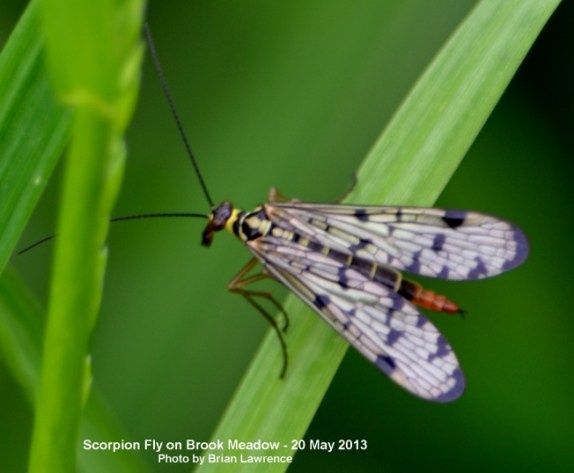
This is the most
common and widespread Scorpion fly in Britain though
there are three Panorpa species in Britain and all
require close examination with a microscope or good
hand lens to distinguish them. I knew I had seen one
before, but did not consider looking in the lacewings
section in Chinery's guide for it. I had seen and
photographed one on Brook Meadow on 5 Sep 2007.
Scorpion Fly has
patterned wings and sturdy beak, but the scorpion-like
tail from which it gets its name is only seen in the
male and is in fact its genitalia - and doesn't sting!
It likes hedgerows, Nettle beds and well wooded areas
and is seen from May to September. They feed mostly on
dead insects, which they frequently steal from the
webs of spiders.
Information from . . .
http://www.naturespot.org.uk/species/scorpion-fly
Insect
survey
I happened to meet
David Search on Brook Meadow this morning. David was
carrying out an insect survey and in one of his little
plastic pots he had none other than a Scorpion Fly. He
said he would be looking at it closely later to
determine the precise species. David also saw the
first damselflies of the year, a pair of Common Blue
mating and a possible immature male Azure Damselfly.

Water
Vole
I met Graham Petrie on
the main river path at bout 3.15 this afternoon. He
had just seen a Water Vole on the west bank of the
river immediately beneath the old gasholder. This was
particularly interesting as we have had very few
sightings from this area of the river this year (only
6 in fact until today).
OTHER
NEWS
Turtle
Dove in Havant
Ralph Hollins had some
luck yesterday when Tony Gutteridge phoned him to say
he had a Turtle Dove in Grove Road, Havant. Ralph was
there within minutes and luckily so was the bird,
perched silently in full view on a tree top, but
within a few more minutes a pair of Magpies decided to
chivvy it out of their territory and the Dove was last
seen flying west towards South Street. Ralph doubts
that it stayed in Havant Town though why it should
stop here in the first place is a mystery. This was
the first Turtle Dove of the year in the local area.
See Ralph's diary entry for Mon May 20 . . .
http://ralph-hollins.net/Diary.htm
Nightingales
at Marlpit Lane
I had a walk along
Marlpit Lane this afternoon and heard Two Nightingales
singing loudly just past the first bend north of the
amenity tip. I listened for Turtle Dove, but did not
hear anything.
Terns
at Hayling Oysterbeds
Tony Wootton spent a
couple of hours at the Hayling Oysterbeds this
afternoon. He saw 6 to 8 Common Terns, no Little
Terns, 5 Oystercatchers, hundreds of Black-headed
Gulls. The noise was overwhelming he says.
Tony's
photo shows some of the Black-headed Gulls on nests on
the island,
with two Black-headed Gull chicks and a single Common
Tern
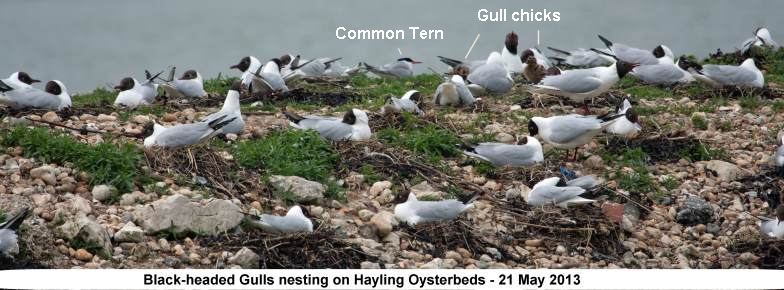
See Chris Cockburn's
report on the breeding activity at the oysterbeds in
yesterday's blog entry. Chris counted an astonishing
1,149 Black-headed Gull nests on the two small
islands.
House
Martins at Funtington
Paul Cooper reported
that House Martins have returned to his house in Lynch
Down Funtington. They arrived on 18 May and a pair
appear to be nesting under the eaves. They disappear
during the day (hunting insects presumably) but return
at night. As he was writing, 10 were flying high above
the house. Last year Paul said they nested but then
all disappeared by mid-May - we thought because of the
awful wet weather. We hope they have more success this
year.
Lapwing
on Farlington Marshes
Bob Chapman reports
that the Lapwing are getting on pretty well so far.
There have been losses of clutches to predators, but
there are now at least four hatched broods around the
reserve and a number of others should be getting close
to hatching. Bob also thinks there are at least four
pairs of Redshank with territories on the
reserve.
MONDAY
MAY 20 - 2013
WAYSIDES
SURVEYS
Jane Brook and I
continued our (not so) regular Monday morning surveys
of the Emsworth waysides. The weather was fine and
warm. We surveyed two of the north Emsworth waysides
together. Jane continued with the other two as I had
to leave early for a hospital appointment. Jane found
the Common Spotted Orchid had come up on the
Greville Green (west) wayside, but was not yet in
flower. Jane found a rather groggy looking
Cockchafer on the pavement on Horndean Road.
After taking some photos we placed it in the dense
vegetation on the Spencer's Field wayside.
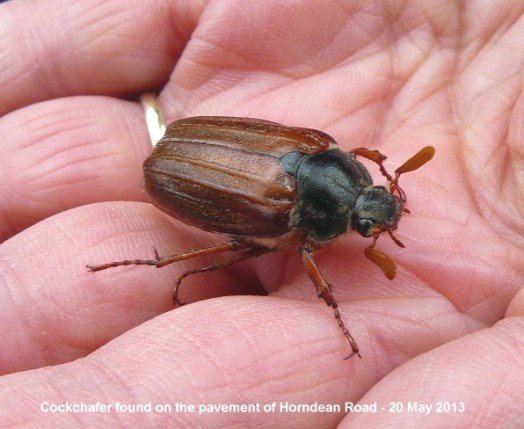
The full report with
photos is on the waysides blog at . . .
http://www.emsworthwaysides.hampshire.org.uk/few-NEWS-current.htm
PORTSDOWN
HILL
After my hospital
appointment, I had a stroll around Fort Widley and
Fort Purbrook. No sign of any orchids, but there were
Cowslips and Crosswort everywhere.
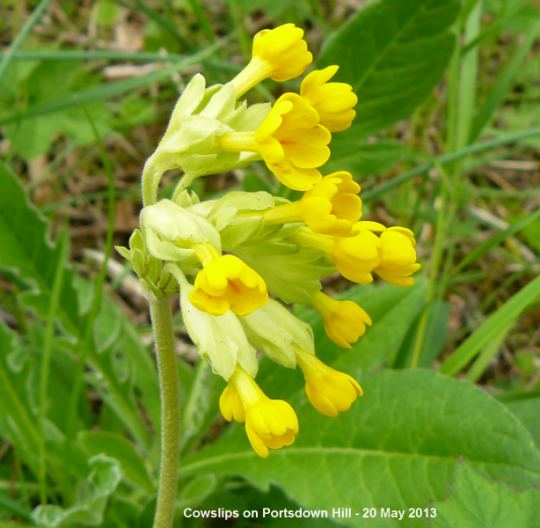
Several Swifts were
flying over Fort Widley. Lesser Whitethroat was
singing behind Fort Widley. Swarms of St Mark's Flies
were in the air, but only at Widley. Here is one
feeding on Crosswort.
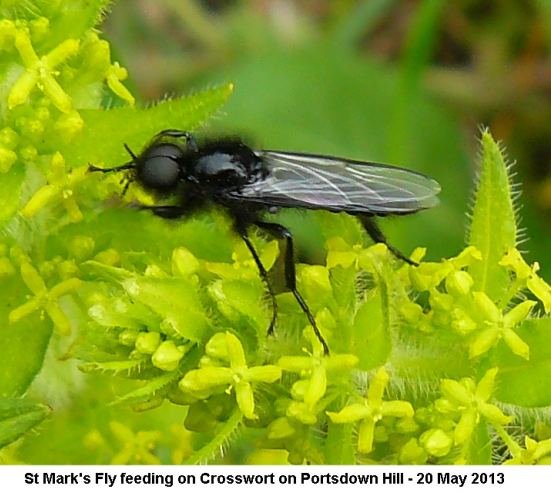
Other flowering
plants; Wayfaring-tree, Red Campion, Bird's-foot
Trefoil, Germander Speedwell, Hoary Cress, Field
Madder, Beaked Hawk's-beard, Lots of Oxeye Daisies
were in bud in front of Fort Purbrook, but none was
open. Two extra plants at Fort Purbrook were Common
Milkwort, Bugle and Salad Burnet. Upright Brome with
hairs on the edge of the leaves was abundant as was
Glaucous Sedge.
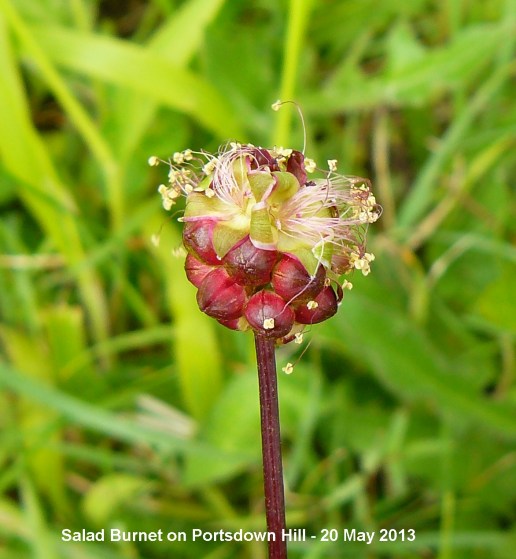
BROOK
MEADOW
Brian Lawrence arrived
at Brook Meadow at about 10.30 this morning as he got
out of the car he was greeted with the call of a
Cuckoo. He saw a large bird fly off which might
have been it. Brian also sent a photo of an insect
with mottled wings. It turned out to be a Scorpion
Fly - see entry for May 21 for discussion and
photo.
HAYLING
OYSTERBEDS
Chris Cockburn sends
his regular update:
"There are now
increasingly larger numbers of Black-headed Gull
chicks to be seen, but the very close proximity of
some nests will create problems for these fiercely
territorial birds. It is no surprise that the
Oysterbeds' islands look crowded. There are no less
than 1,149 Black-headed Gull nests there (110
more than in 2012). There were 550 nests on NE Island
and 599 nests on SW Island - the round figure of 550
is typical of summed totals for bird/nest counts and,
perhaps, I did miss one nest on SW Island!
The density of gull
nests obviously precludes good numbers of nesting
common terns; however, 8 Common Tern pairs are
fighting for territory (1 on North/East/Banana Island)
and 7 on West/South Island). We really must have a
competition to decide on names for these two islands -
please do offer suggestions (printable, of course) -
we would use the most popular!
There were three
Mediterranean Gull nests seen - but it is possible
that one or two were missed - it will be a case of
finding a special viewpoint.
As expected, there
were no Sandwich Tern nests and, as yet, the
3 pairs of Oystercatchers have not found
suitable places.
The recently imported
shingle (western end of the "NW Bund") is proving
attractive to Little Terns and to an oystercatcher
pair and a common tern pair that might well try
nesting there (encouragingly, a ringed plover was
there on Sat & Sun). If Little Terns do nest
there, they might become of interest to a Kestrel that
regularly hunts nearby - hopefully, any Little Tern
chicks will start a new fashion and actually use
chick-shelters. So far, no Little Terns have shown
interest in the bare shingle area north east of the
lagoon on the "North Spit" (a better name, please?!).
It is hoped that
weather conditions will be good enough to do a nest
count on the harbour islands soon - the count will
have to be done at some time between Wed 22 May
&Tue 28 May, before the main hatch starts (eggs
are static - small chicks not so!) "
SUNDAY
MAY 19 - 2013
Drama
on Brook Meadow
As I was walking
through the south meadow this afternoon, I heard
someone screaming 'I can't swim' from the river on the
other side of the embankment. I rushed over to the
south bridge only to find a crew of young people
filming a girl being rescued from the river. In fact,
I watched a second take of the action as the girl was
first pushed into the river and then hauled out by a
boy.
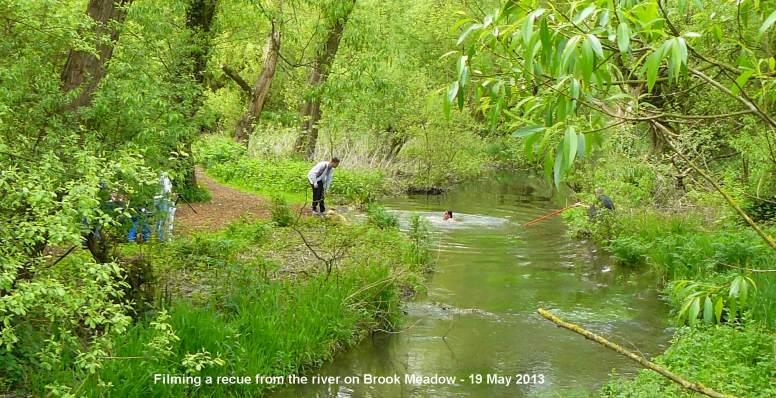
Speaking to the group,
I discovered that the film was a drama written by a
young student of Southampton University for her MA
thesis. The crew and actors were her student friends
helping with the filming. The photo (taken from the
south bridge) shows the girl in the water and her
lover on the bank preparing to rescue her. The film
crew is behind the bushes on the left. The chap on the
opposite bank had an underwater camera on the end of a
stick to film her agonies from under the water. I
explained to them that this was a nature reserve, and
they were very understanding, but there was no
question of their doing any damage or lasting
disturbance. So I wished them good luck and went on my
way.
SATURDAY
MAY 18 - 2013
BROOK
MEADOW
Young
Water Vole
Malcolm Phillips saw
what looked like a young Water Vole in the river
beneath the railway embankment on the north path at
10.30am.
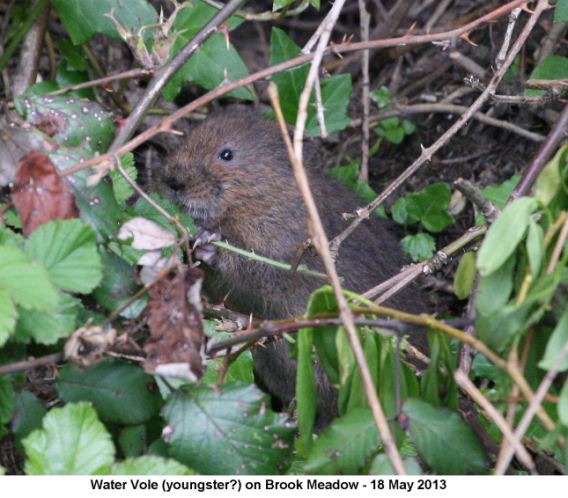
Whitethroat
I watched one of our
Whitethroats from the north path. It occasionally
perched on the tall stems of dead vegetation singing
its short scratchy song.

Common
Comfrey
Both purple and white
flowered varieties of Common Comfrey are now out on
the south meadow, about 2 weeks later than usual. I
always puzzle over comfreys as to whether they are
Common or Russian Comfrey.
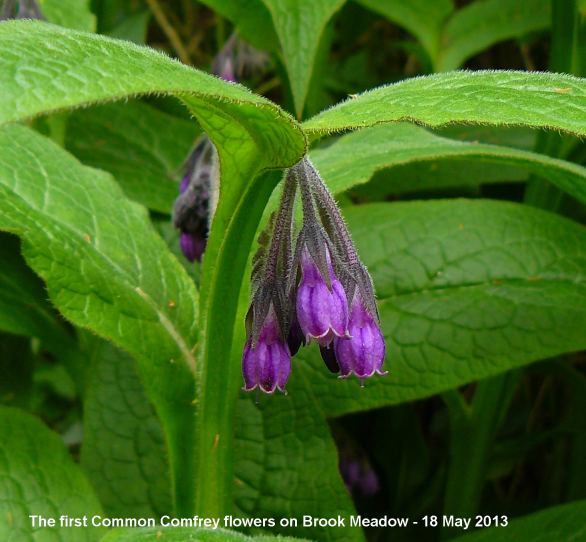
I looked closely at
the stems, but all plants appeared to have strongly
winged leaves running down the stem suggesting they
are Common Comfrey and not Russian Comfrey, where the
wings only slightly run down the stem. Also, Rose
(p.364) states that Common Comfrey flowers before
Russian Comfrey ie May-Jun as opposed to Jun-Jul,
which also supports the Common Comfrey identification.
Sharp-flowered
Rush
The leaves of
Sharp-flowered Rush can be seen all over the Lumley
area, pushing their way up through the matted dead
grasses (the Lumley area was not cut and raked last
year). These plants were first seen on Brook Meadow in
2009 on the western side near the cross path, but have
spread each year since then. They must be spreading
through their far-creeping underground stems
(rhizomes).
Greater
Pond Sedge
Greater Pond Sedge is
now very prominent on the east side of the Lumley area
near the Lumley Stream. The brown male spikelets are
at the tip of the stem and the female spikelets below.
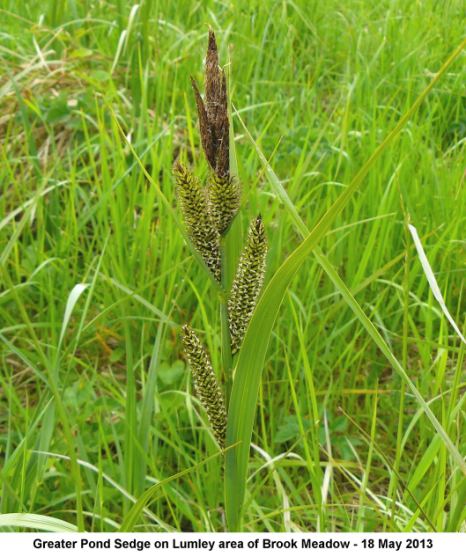
The key to
identification are the long sharp-pointed tips to the
female glumes; Lesser Pond Sedge has short pointed
tips to the glumes. Lesser Pond Sedge grows on the
banks of the River Ems on the west side of Brook
Meadow.
Other
plants
There were just a few
Cuckooflowers out on the south meadow, in sharp
contrast to the hundreds still in flower on the Bridge
Road Wayside. There is no sign of any Ragged Robin
on the Lumley area or elsewhere. It is usually out
by now, though last year was a very poor one. Lots of
leaves of Wild Angelica are present on the
Lumley area. I also noticed Yellow Iris in
flower for the first time on the edge of the Lumley
Stream, 2 weeks later than last year.
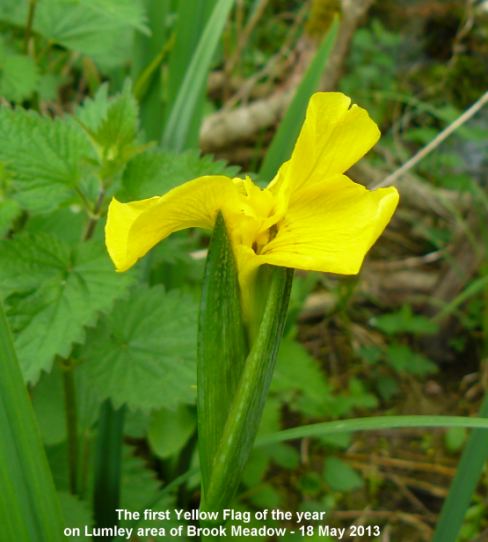
OTHER
NEWS
Swifts
Susan Kelly alerted me
to the arrival of Swifts in Emsworth; she heard some
flying over her house in Kingsley Avenue Emsworth this
morning. Then, this afternoon, we had three of them
screaming over the houses in Bridge Road, here one
moment and gone the next. These were probably just
passing through, but it is encouraging to know they
have arrived, albeit about a week or so later than
usual.
Water
Vole in Havant
Bernard Gudge and his
wife watched a Water Vole feeding close to the reeds
in the stream near the entrance to the dialysis unit
in the De La Rue building in Havant today. Bernard
noticed there were anti-vermin boxes about the site
which he hopes won't be a problem.
Havant
Wildlife Group walk
Ros Norton reported on
this morning's walk by the Havant Wildlife Group from
Sinah gravel pit around Gunnar Point and Hayling Ferry
on a bright, dry morning. For the report go to the
special web page for the 2013 walks at . . .
Havant
Wildlife Group
FRIDAY
MAY 17 - 2013
Swan
'litter nest'
Rosemary Hampton
reports that the pen swan is still sitting on 6 eggs
on the "litter nest" on Emsworth Millpond and has
collected a piece of builders' merchant bag for the
nest. Has there ever been a nest like this one?
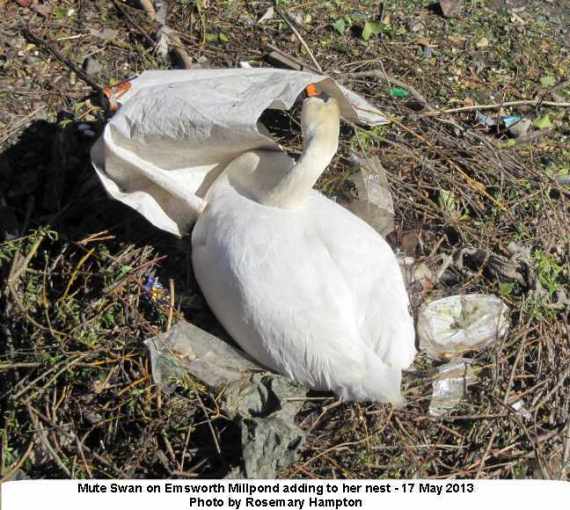
Rosemary says the male
is busy keeping other birds at bay, ducks, doves,
pigeons and gulls all attracted by bits of bread
thrown to the swan. This morning I watched the cob
attack another swan that came a bit too close,
continually biting its neck. This territorial activity
of the cob probably explains the relative absence of
Mute Swans anywhere on the millpond at present.
Long-tailed
Tit young
Francis Kinsella was
on Brook Meadow this afternoon when he captured this
delightful image of two young Long-tailed Tits begging
to be fed. This confirms breeding of this species on
the Brook Meadow site. The photo was taken near the
railway bridge in the north-west corner of the Seagull
Lane patch.
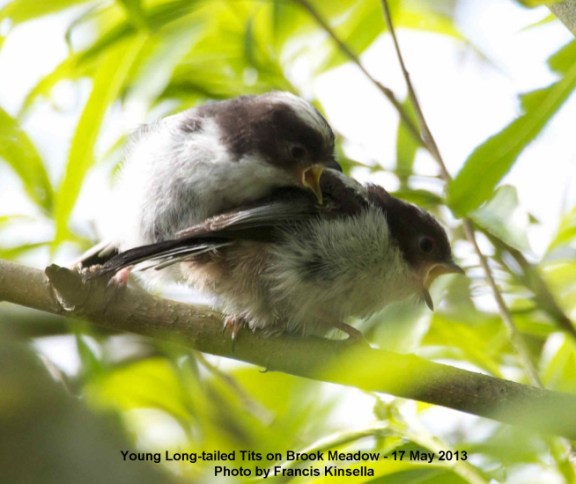
Ham
Wall, Somerset
Tony and Hilary
Wootton visited the Ham Wall RSPB reserve in Somerset
last week and saw some good birds and heard Bitterns
booming. Sounds like a good place for a visit. Ham
Wall is near Glastonbury, Somerset. Grid reference:
ST449397.
Here
is Tony's smashing photo of a Hobby
showing well its black and white head, heavily
streaked underparts and rufous vent.
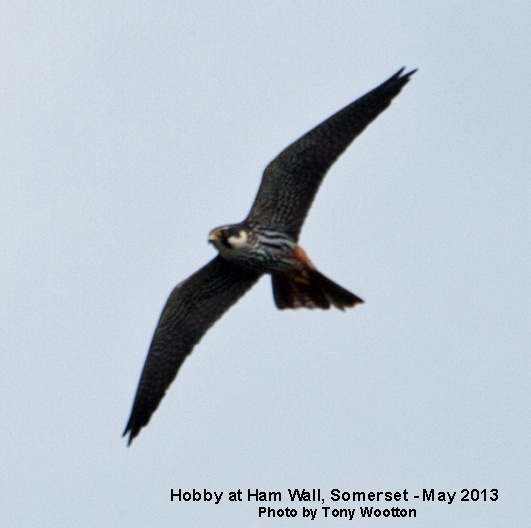
Tony
also got this Swift, a bird which I still not have
seen in Emsworth this year.
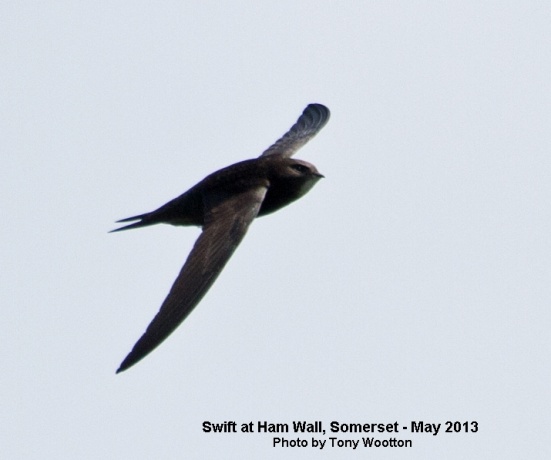
For
earlier observations go to . . May
1-16